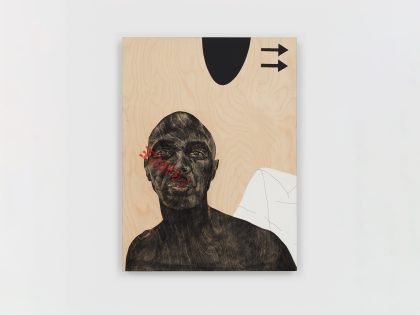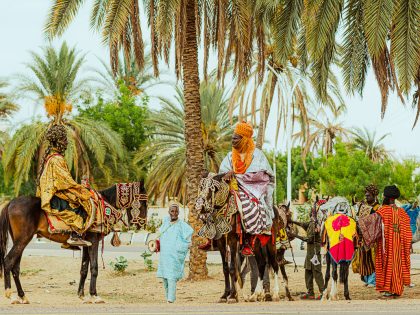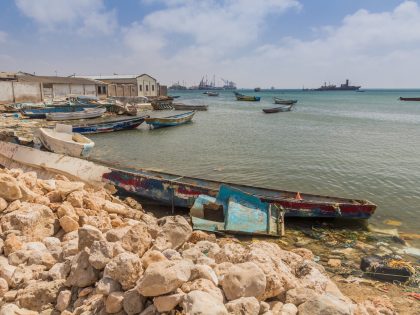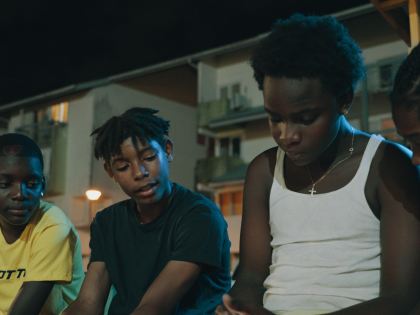A wild fig grows in Rowan Street
Professor Sampie Terreblanche, who passed away at 84 on February 17, 2018, was one of South Africa's foremost political economists.

Professor Sampie Terreblanche is always swimming against the tide. “At the moment I am a very unpopular man in Stellenbosch. Around here, there’s a group of people that find me terribly annoying. There is an irrigation canal running through our neighborhood and some of the people have enclosed it, claiming it forms part of their properties. I wrote a letter to the Eikestad News [a local weekly newspaper] suggesting the council proclaim the canal as public property. Now, the people with homes bordering the canal are all mad at me, because they want to include it as part of their properties. But I say, no, it shouldn’t be allowed, it should be public property.”
Prof Sampie doesn’t look too perturbed. After all, this is not the first time that he has taken an unpopular stance. When you enter his house in Rowan Street, a framed picture on the cupboard catches your eye: Prof Sampie in conversation with the late President Nelson Mandela. Together with Willie Esterhuyse, Marinus Wiechers and other white Afrikaner academics, Sampie held clandestine meetings with ANC leaders like Jacob Zuma and Essop Pahad in the 1980s, when it was unpopular, long before the ban on the ANC was lifted in 1990. In his testimony to the South African Truth and Reconciliation Commission in 1997, Sampie advocated for a wealth tax. For this he received fierce criticism. And, perhaps the worst sin of all, for someone living in the Stellenbosch Winelands: He prefers gin over wine.
“Jislaaik?, people love to talk about wine! Unbelievable. In that sense I am an outsider. I cannot evaluate all that wine talk; I know nothing about wine.”
The fight over the irrigation canal is more than a small-town tiff. For someone who devoted his life to questions about inequality and social justice, questions about property, wealth and the public good lie at the centre of being human. It is about the question of how one lives an ethical life.
“How should things be? Jislaaik, this is very difficult. But it is the question we should be asking continuously. It goes through my head at night before I go to bed. When I was a child, I sat in church and asked myself questions like “where did it all begin?” “How did everything begin?” And still I wonder: ‘How should we organise life?’”
This, obviously, is a question of interest to an economist. The question about inequality has been central to his work for many years—it is the topic of 12 books and a host of journal articles and book chapters. But although Prof Sampie holds three honorary doctorates in economics related subjects, he locates his own work primarily in the humanities. “I am not an economist. I am a political economist. There is a world of difference between them. An economist is someone who busies himself with how to make money. A political economist does the household economics of the state. Or the people’s household economy. Isn’t that a nice way of looking at it? One who asks how the nation’s household economy should be organised.”
For Sampie this is not merely an academic question. It is a question about the meaning of being here, one that presented itself again recently when he read the latest book by his friend and fellow Stellenbosch professor, Anton van Niekerk, about death and the meaning of life.
“Why are we here? It is to make this place a better place, a morally better place. Are we succeeding, in the midst of all this snobbery and arrogance? This is quite an important question. Are we using our talents and opportunities in an ethically correct manner? This is the question we should be grappling with.”
It is also, especially, a question for someone facing his own mortality.
‘“I received some bad news a few months ago. I have been diagnosed with brain cancer. It has not had any effect at all; I still feel completely healthy. According to the doctors it could take six months, or two years. They do not know at all.”
So the time has come to look back. Prof Sampie looks at the voice recorder on the table. “I bought myself one like this too. I want to put stories on it. My memories, to see if I can do something with it. I cannot do serious work anymore. Over the years I thought I had a good memory. I remember dates. I have given many lectures.”
That’s no exaggeration. He still casually drops names of specific students, anecdotes, special moments. What were the highlights?
“There are so many. I’ve taught here in Stellenbosch for 52 years. Probably to about 10,000 students. I must say I enjoyed it very much. The majority of students were women and I must admit that had I only taught male students, the whole experience would have been much less pleasant. I suppose I was more successful in persuading women. If a student smiles, and you can see she understands, she gets what it is about … that is quite an experience.”
In 1951 Prof Sampie was himself a first year student at Stellenbosch. Then there were 3,000 students, now there are close to 30,000. The university became “an unbelievably better place” over the years as it developed into a prominent research university. “The standard improved a great deal, it is incomparable.”
Nevertheless, there are many lamentations about the university, especially about its language policy, as it has been moving away from Afrikaans as a language of instruction.
“There is now a battle raging about English and Afrikaans. Now, I failed English at school in the Free State – it was the only subject I ever failed in my life. Afrikaans is important to me, but I am not going to wage war for it. For me the biggest issue in this country is the question of poverty, especially among black people. It is terribly bad.”
His empathy for the poor is linked to a political awakening in the 1970s, when he investigated poverty among Coloureds as a member of a government commission, the Erika Theron Commission. That work changed him irrevocably.
“The exposure to poverty touched me. I wasn’t the same person anymore after that Commission.”
But it is still the same Professor Sampie. Only recently, in November last year, he wrote a column for Media24’s newspapers titled “What are we to do?”: “In the one corner, the white elite lives in undeserved luxury and extravagance. In a second corner, the black elite also lives in luxury and extravagance. In the third corner, the black majority lives in inhumane poverty and squalor. The question is: What are we going to do about it?”
Reactions to his article were not exactly positive.

Are things going to get better?
In response to this question, he gets up to fetch a print-out of a graph that compares inequality in South Africa with that of other countries. He points to a red dot halfway on the page, far above Brazil and India.
“We are completely out of step. What is needed, is that we move this dot down. But I don’t know how we are going to do that. It grips your heart.”
Another graph shows how white South Africans became more prosperous after the arrival of democracy in 1994. “Actually, white people have done incredibly well for themselves. They enjoy life. They have access to private health care and tertiary education that compares with the best in the world. White people have never had it as good as in the past 20 years. But do they complain!”
In Stellenbosch he is confronted on a daily basis with the contrast between rich and poor.
Stellenbosch is a town for the wealthy; a wealth cult. I don’t think there is another town of this size in the country with so many rich people. Linked to this wealth, of course, there is snobbery. The snobbery of the people of Stellenbosch is unbearable. They think they are terribly smart. But there is also no doubt that there are some very interesting people here. The level of schooling is of course very high. Actually, it is a fantastic place. To have lived here for 52 years is a big privilege, no doubt about it.”
In this modest house he lived, worked, and thought. In this town he broadened the minds of generations of students. But he also realises: after he goes, the bulldozers will come.
“It is incredibly how many old homes here in the neighborhood of Mostertsdrift have been knocked down in order to build new ones. When I kick the bucket in a year’s time or so, this house will also be knocked down. And it is such a nice home, such a nice place to live in. The old character of the town has disappeared.”
Before I leave, Prof Sampie takes me to his back garden, green despite the drought gripping the Cape. He wants to show me the wild fig tree in the yard.
“This is an incredibly big tree, I planted him myself in 1964. He is gigantic. We can use water from the irrigation canal, you see, this is why he grew so very big.”
There, against the fence, the wild fig tree towers above us. Branches gesturing like swinging arms, bearded leaves hanging down to the ground. And at the bottom of the knotty trunk, the roots are visible, there were they anchor the old giant in the Stellenbosch soil.
* Professor Sampie Terreblanche, aged 84, passed away on February 17, 2018, in Stellenbosch, South Africa. This is an edited translation, from Afrikaans, of what turned out to be Professor Terreblanche’s last media interview. It was first published in Stellenbosch Visio.



















